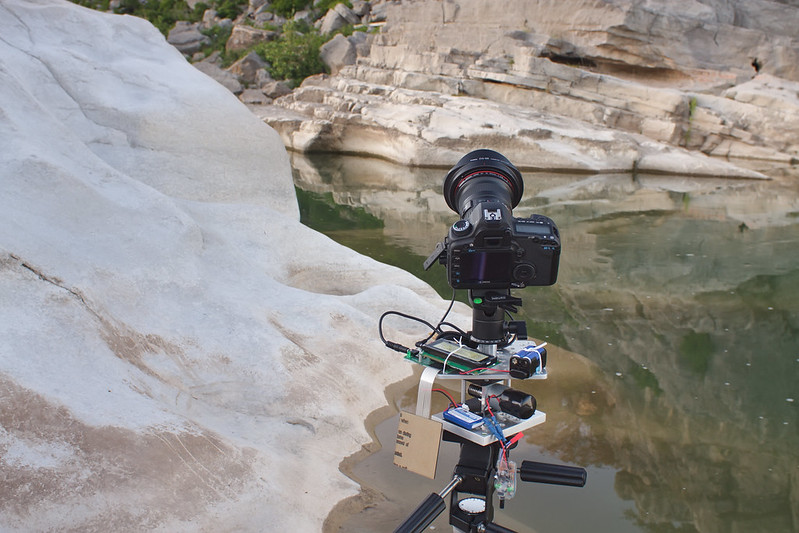motleypixel
Newbie level 5

- Joined
- Apr 26, 2012
- Messages
- 9
- Helped
- 0
- Reputation
- 0
- Reaction score
- 0
- Trophy points
- 1,281
- Location
- Austin, TX
- Activity points
- 1,397
Hello everyone,
Pretty cool how the new post title generates a possible "search" for the user...nice forum module to implement. I've lurked here the past two days, so I've read a bit and feel I needed to register to get some dialog going on this project.
First post, looking forward to leveraging this community. Background: In a nutshell, I have a business degree, but was 6 years US Navy Submarines (reactor operator). I know fundamentals with regards to electricity and some solid state stuff, but really zero experience in design.
I have a one-off requirement and was wondering if this community could help.
First of all, the system: I have built a DIY Time-Lapse Photography Turn Table: **broken link removed**
I'm controlling the camera with a smart device called a Little Bramper: **broken link removed** Essentially this device can bulb-ramp the shutter.
I'm panning the camera with a worm-gearbox that has a 30:1 gear ratio, powered by a 7.4VDC 2-cell lipo battery, speed controlled by a simple PWM controller. The controller is variable from 0-100% modulation and will recall last setting upon pwr interupt.
Problem: As the turn table rotates very slowly (1 rev. per hour) and the camera begins taking pictures (starting out as a shutter open duration of 40ms or 1/40th sec and ~ 3 second delay before the next shot and then after time goes on the shutter open duration increases to the tune of 2+ seconds). I have found that shutter speeds slower than 2 seconds, with the moving turn table, produces motion blur that is too excessive.
Best solution: Stop the power to the speed controller which will stop the power to the DC 1rpm motor, which will stop rotation of the camera.
How to implement the solution?: The good news is that the Little Bramper has a Green LED that energizes for the exact duration of the shutter open cycle, so if the shutter is at 1/40th second, then the illumination period of the LED is 1/40th second, same with a 2 second shutter speed, etc.
I would like to find a way to harness this LED signal (either light from the LED or Vd across the LED) to electronically open the pwr CKT to the motor speed controller.
Any ideas here?

Thanks!
Pretty cool how the new post title generates a possible "search" for the user...nice forum module to implement. I've lurked here the past two days, so I've read a bit and feel I needed to register to get some dialog going on this project.
First post, looking forward to leveraging this community. Background: In a nutshell, I have a business degree, but was 6 years US Navy Submarines (reactor operator). I know fundamentals with regards to electricity and some solid state stuff, but really zero experience in design.
I have a one-off requirement and was wondering if this community could help.
First of all, the system: I have built a DIY Time-Lapse Photography Turn Table: **broken link removed**
I'm controlling the camera with a smart device called a Little Bramper: **broken link removed** Essentially this device can bulb-ramp the shutter.
I'm panning the camera with a worm-gearbox that has a 30:1 gear ratio, powered by a 7.4VDC 2-cell lipo battery, speed controlled by a simple PWM controller. The controller is variable from 0-100% modulation and will recall last setting upon pwr interupt.
Problem: As the turn table rotates very slowly (1 rev. per hour) and the camera begins taking pictures (starting out as a shutter open duration of 40ms or 1/40th sec and ~ 3 second delay before the next shot and then after time goes on the shutter open duration increases to the tune of 2+ seconds). I have found that shutter speeds slower than 2 seconds, with the moving turn table, produces motion blur that is too excessive.
Best solution: Stop the power to the speed controller which will stop the power to the DC 1rpm motor, which will stop rotation of the camera.
How to implement the solution?: The good news is that the Little Bramper has a Green LED that energizes for the exact duration of the shutter open cycle, so if the shutter is at 1/40th second, then the illumination period of the LED is 1/40th second, same with a 2 second shutter speed, etc.
I would like to find a way to harness this LED signal (either light from the LED or Vd across the LED) to electronically open the pwr CKT to the motor speed controller.
Any ideas here?

Thanks!
Last edited:







